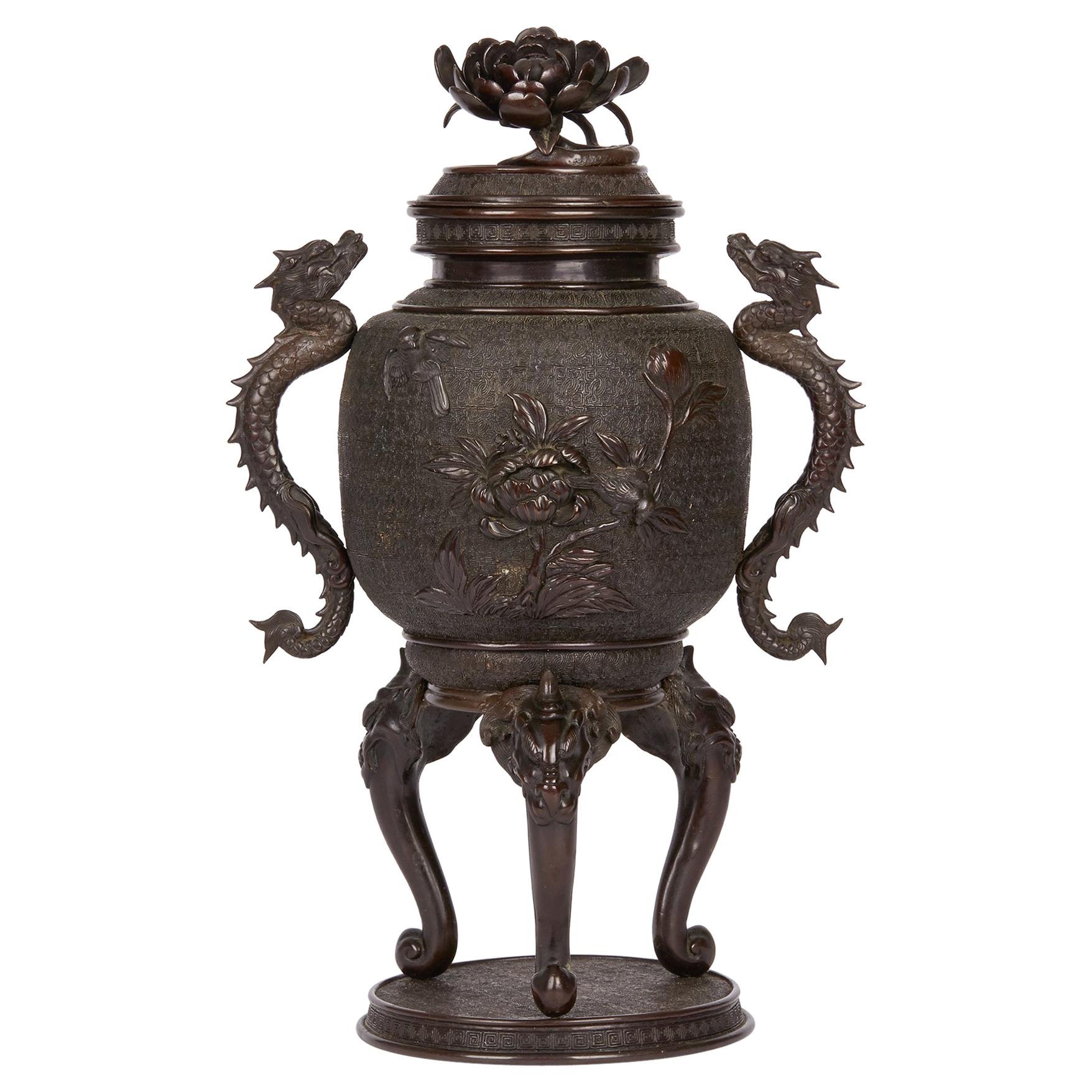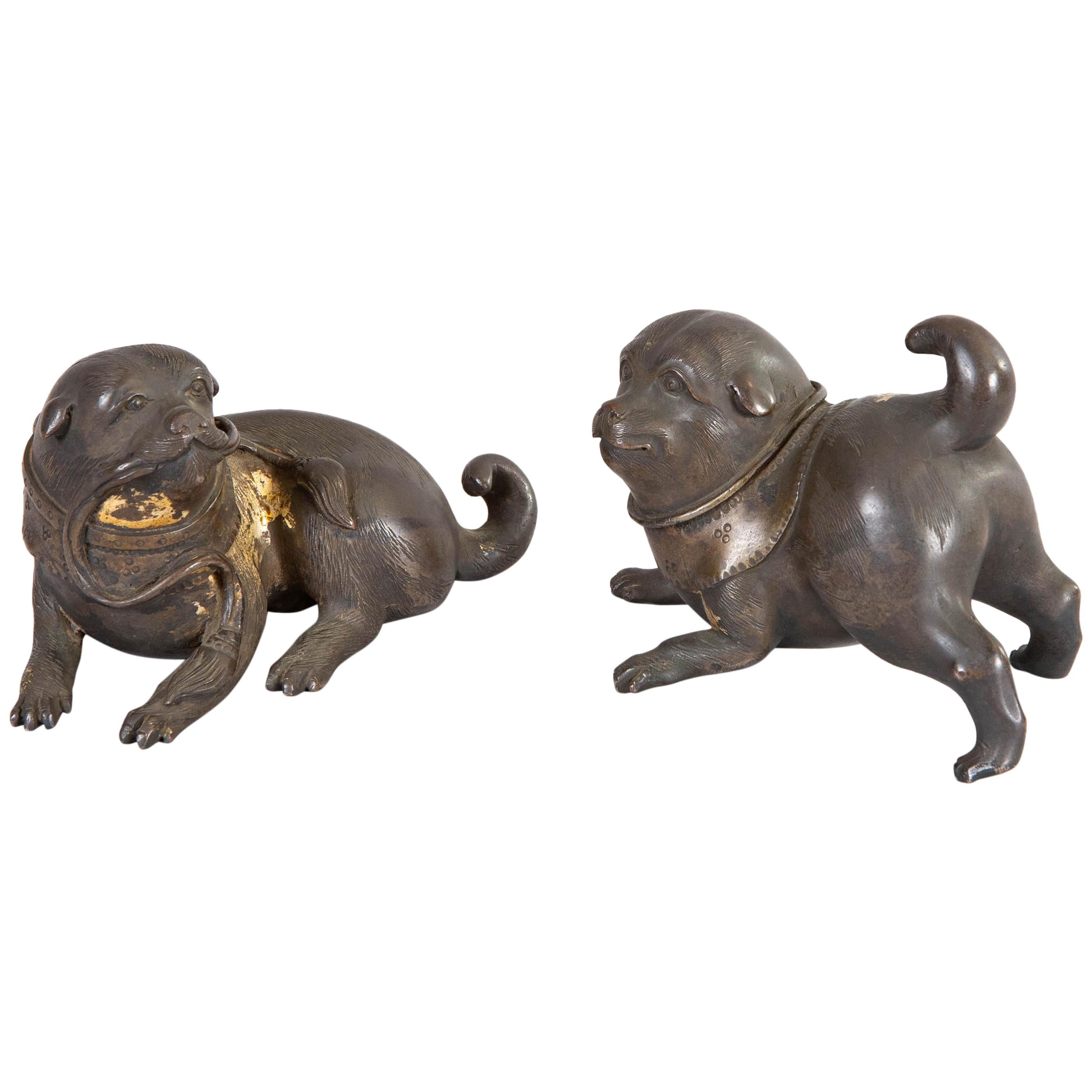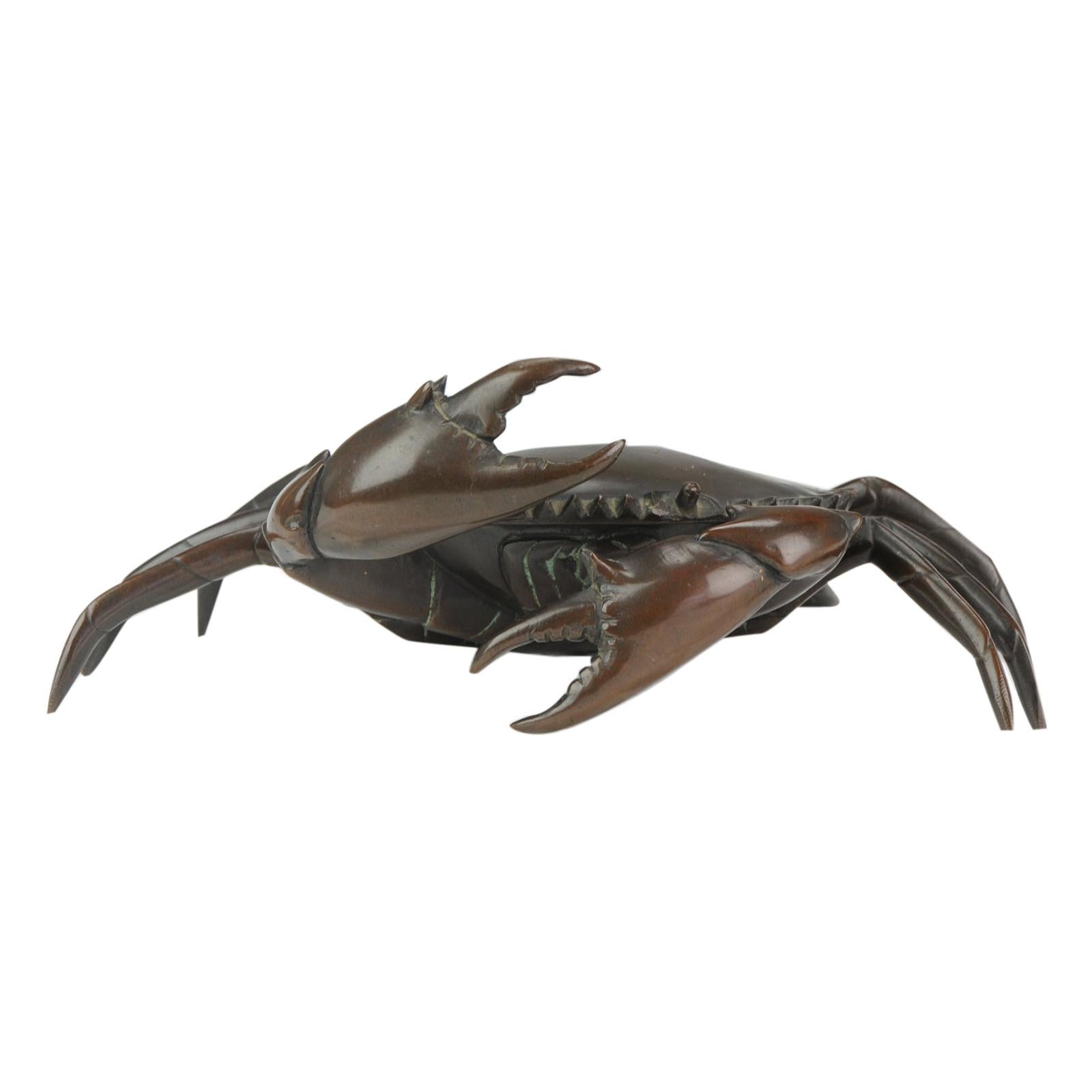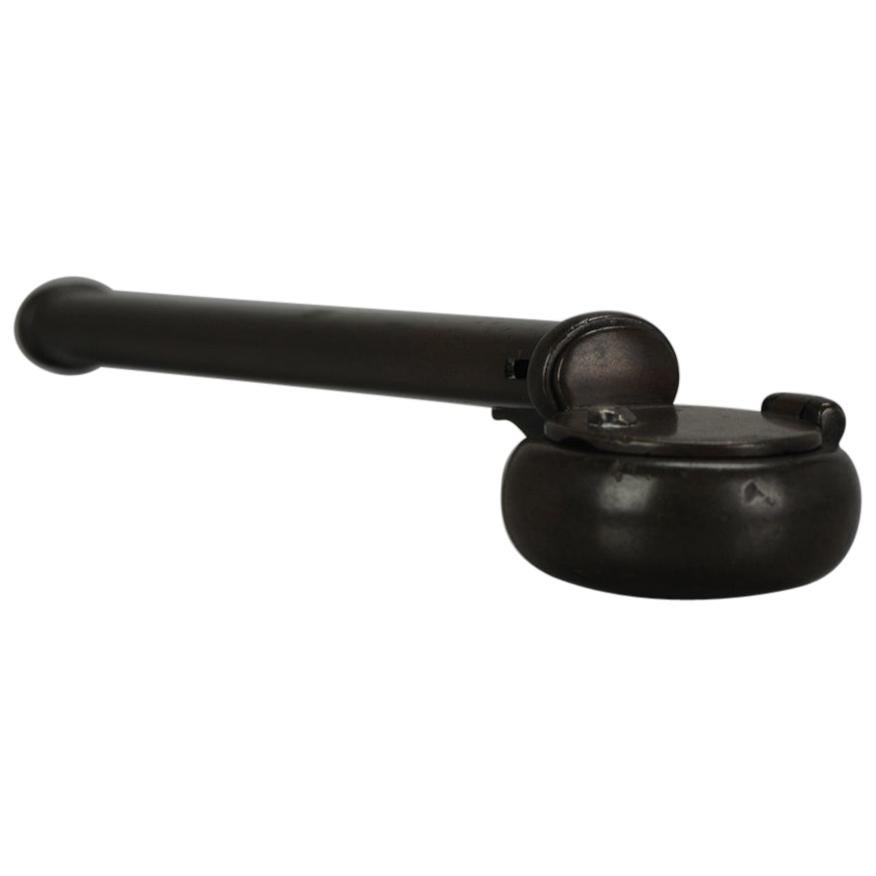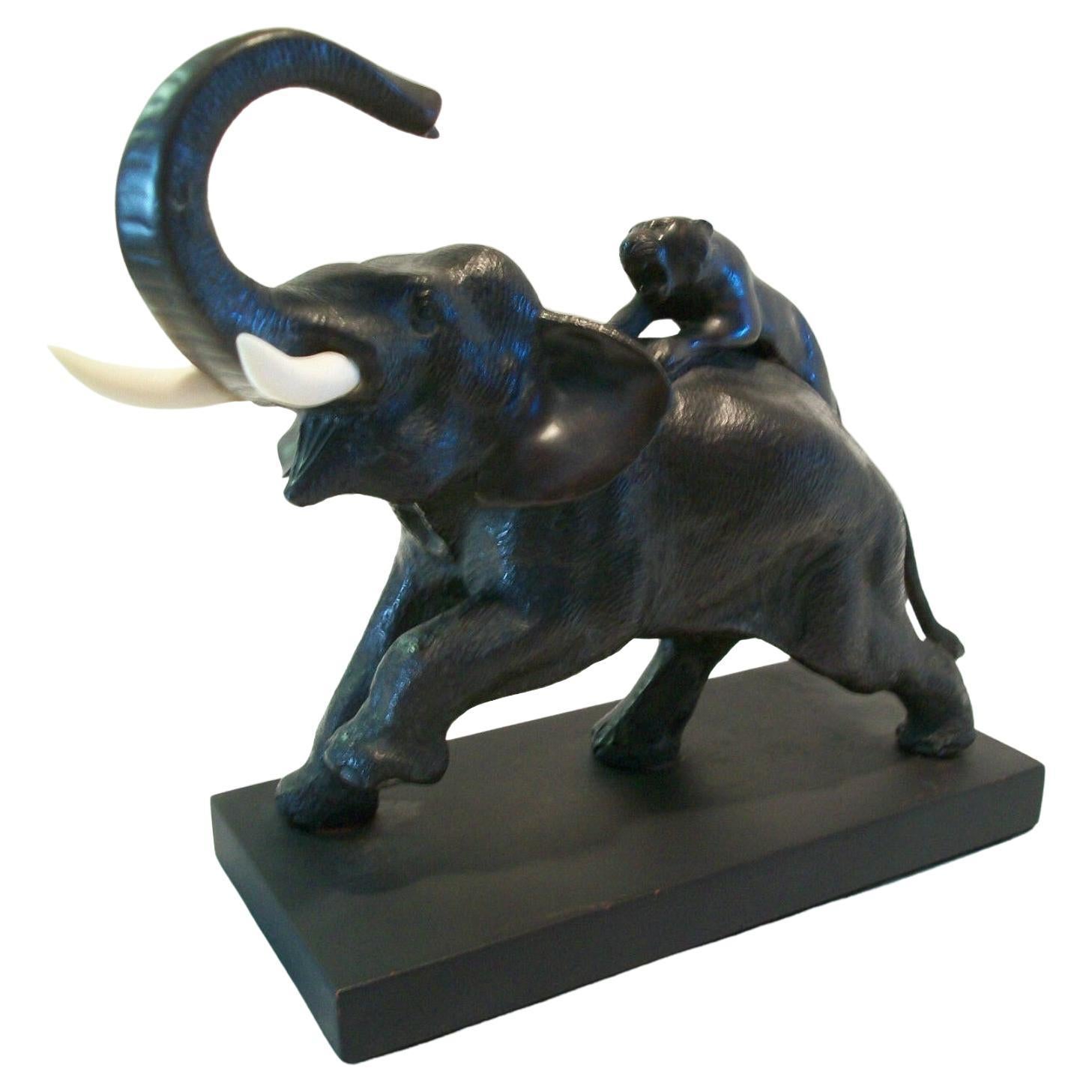Items Similar to 19th Century Japanese Silver Inlayed Bronze Representing Daikoku
Want more images or videos?
Request additional images or videos from the seller
1 of 11
19th Century Japanese Silver Inlayed Bronze Representing Daikoku
About the Item
From the Estate of Paul & Clara Kellner. This large bronze of Daikoku or the God of Prosperity closely associated with farmers, agriculture and rice staples of Japanese life and stability. His attributes are a co-mingling of Indian Buddhist forms of Shiva and the Shinto God Okuninusti. The God is almost invariably showing standing on two bails of rice wielding his magic mallet and caring a treasure sack. The casting is very good and as a further decorative feature, the piece is inlaid with silver at the borders of his clothing and across the front of his robes. Other inlays are at the eyes and on the key elements of the base. Signed the bronze is a fine example of late 19th-century work from Japan. The Kelllner's, both Europeans displaced by the war, came to America and started a new life in new surroundings. After several jobs, the Kellner's through a generous gift started a tie manufactory and within a very few years became the talk of New York selling ties to J. C. Penny. The firms name Better Cravats was by the 1960s selling ties worldwide with sales exceeding five million anally. Their home was on Fifth Avenue and they generously supported philanthropic causes and had a country home in Columbia County.
Condition Disclosure:
While we do our best to carefully inspect and give a full report on the condition
of any item we sell, pointing out any repairs or alterations that may have been
done to the best of our knowledge, as is the case with any antique and vintage item,
there is a possibility that at some point in the life of the piece that there
may have been damaged which has been professionally repaired and
as such a repair undetectable, it is therefore impossible for us to disclose...
we recommend that you also read and agree to the 1st dibs user agreement,
particularly sections 9,13,15,18,19 and 27
- Dimensions:Height: 21.5 in (54.61 cm)Width: 11 in (27.94 cm)Depth: 7 in (17.78 cm)
- Materials and Techniques:
- Place of Origin:
- Period:
- Date of Manufacture:1895
- Condition:Wear consistent with age and use. Good condition with some small areas of change to the bronzes patina but overall great color and original surface.
- Seller Location:Hudson, NY
- Reference Number:1stDibs: LU81138361113
About the Seller
4.7
Vetted Seller
These experienced sellers undergo a comprehensive evaluation by our team of in-house experts.
Established in 1978
1stDibs seller since 2005
323 sales on 1stDibs
Typical response time: 20 hours
- ShippingRetrieving quote...Ships From: hudson, NY
- Return PolicyThis item cannot be returned.
More From This SellerView All
- 19th Century Chinese Bronze Dancing FigureLocated in Hudson, NYThe charming figure done completely in the lost wax method is in a primitive naive style. The male figure is dancing excitedly on a rocky outcrop. His costume of a loose-fitting coat...Category
Antique 19th Century Chinese Sculptures
MaterialsBronze
- Late 19th Century Chinese Gold Fleck Cast Bronze Figure of BuddhaLocated in Hudson, NYThis work cast in bronze with a gold fleck finish to the clothing was made in the last quarter of the 19th century. The patina and color of the figure has lovely rub through and sits...Category
Antique Late 19th Century Chinese Sculptures and Carvings
MaterialsBronze
- 19th Century Tibetan Patinated Bronze Figure of Tara on New Black BaseLocated in Hudson, NYThis fine old bronze of Tara was made for the purpose of focusing on the process of meditation regarding her aspects of wisdom and compassion. Crafted in Tibet but nearer to India and its influences this figure is an interesting combination of Hindu and Buddhist art and religion. Originally Tara was conceived as a Hindu mother goddess with the spread of Buddhism she was redesigned sometime after 4th century giving her a new role within the spreading Buddhist religion. This seems to have taken place in Shri Lanka and then spread out and back into India and Tibet thru China. At this time Shri Lanka was a great trading center and was host to many religious aspects, sects and ideals. The figure is cast with many fine details and is patinated in a warm green, brown showing traces of a coppery red color. The bronze content of this figure has a high amount of copper in the smelting giving the bronze a rich internal red color. Seated in lalitasana with her pendent right foot resting on a separately cast Padma or lotus pillow...Category
Antique Mid-19th Century Tibetan Tibetan Sculptures and Carvings
MaterialsBronze
- Late 19th century Carve Stone Cambodian BuddhaLocated in Hudson, NYThis sage green carved stone Buddha was purchased from an upstate NY garden where it has resided for the last 120 years. The family began the house and garden in the late 1890s and traveled through China, Southeast Asia and Europe acquiring objects to create a complete retirement home for themselves and their family from New York City. Sculptures like this are a typical form found at Angkor of numerous sizes representing Nagas and used as guardians of temples. This figure was a favorite motif of Angkorean sculptors from the 12 century...Category
Antique 1890s Cambodian Other Sculptures and Carvings
MaterialsStone
- 19th Century Nephrite Jade Carved Plaque on StandLocated in Hudson, NYThis carved Nephrite Jade plaque of a mythical best has the attributes of a dragon and a fish leaping from the water. Carved we believe in the late 18th or early 19th century to be u...Category
Antique 19th Century Chinese Sculptures
MaterialsJade
- Late 19th/Early 20th Century Carved Jade Mythical Bird CarvingLocated in Hudson, NYThis nicely carved bird figure is done in an 18th-century style but is from the very late 19th century to early republic period. The stone is a soft mellow celadon green with dark br...Category
Early 20th Century Chinese Sculptures
MaterialsJade
You May Also Like
- Large Japanese Meiji Bronze Lidded Urn, 19th CenturyLocated in Bishop's Stortford, HertfordshireA large and stylish antique Japanese Meiji bronze lidded twin handle urn standing on a rounded plinth base with tongue and grotesque head formed legs with dragon handles and a flat c...Category
Early 20th Century Japanese Meiji Metalwork
MaterialsBronze
- Pair of 19th Century Japanese Bronze Playful PuppiesLocated in Hudson, NYAntique bronze sculptures of puppies playing. Traces of gold on both, one holding tassels in its mouth. Measurements: 3 1/2" h x 6 1/2" w x 3 3/4" d and 4 1/4" h x 5 1/2" w x 3 3/4" dCategory
Antique Mid-19th Century Japanese Sculptures and Carvings
MaterialsBronze
- Antique Bronze Meiji Okimono Inkpot of a Crab, 19th Century, Japan, JapaneseLocated in Amsterdam, Noord HollandNicely made artifact of a Crab in the use of an Inkpot. Okimono (??, oki-mono) is a Japanese term meaning "ornament for display; objet d'art; decorative object", typically display...Category
Antique 19th Century Japanese Sculptures and Carvings
MaterialsBronze
- Antique Japanese Bronze Hatate 19th C Meiji Inkpot Japan UnsignedLocated in Amsterdam, Noord HollandLovely and very detailed piece. . If someone were to bring up the topic of Japanese antiques, what images would come to your mind? Kimono? Swords? Armor? Possibly netsuke? A few might even know what an inro is. How about the yatate? I have shown a yatate to many of my Japanese acquaintances here in Tokyo, and was surprised to discover that most did not even know what it was! Artists and calligraphers usually knew right away, though. A yatate (pronounced yah-tah-teh) is a Japanese portable writing set. The yatate has been around since the Kamakura period (1185-1333). It contains a traditional Japanese bamboo brush and an ink pot filled with cotton or silk which holds liquid sumi ink. Yatate literally means "arrow Stand." The Japanese traditional way of writing is with a brush (fude) and ink (sumi). Before the invention of the yatate, whenever anyone wanted to write or draw in ink, he had to make his own ink by grinding the ink stick...Category
Antique 19th Century Japanese Sculptures and Carvings
MaterialsBronze
- Antique Japanese Bronze Hatate 19th C Meiji Inkpot Japan UnsignedLocated in Amsterdam, Noord HollandLovely and very detailed piece. . If someone were to bring up the topic of Japanese antiques, what images would come to your mind? Kimono? Swords? Armor? Possibly netsuke? A few might even know what an inro is. How about the yatate? I have shown a yatate to many of my Japanese acquaintances here in Tokyo, and was surprised to discover that most did not even know what it was! Artists and calligraphers usually knew right away, though. nk stick, grinding stone and bamboo brushes A yatate (pronounced yah-tah-teh) is a Japanese portable writing...Category
Antique 19th Century Japanese Sculptures and Carvings
MaterialsBronze
- Antique Meiji Period Bronze & Bone Elephant Sculpture, Japan, 19th CenturyLocated in Chatham, ONAntique Meiji Period bronze and bone sculpture - dramatic fine casting of an elephant and tiger - mounted to an black painted wood base - unsigned -...Category
Antique Late 19th Century Japanese Meiji Sculptures and Carvings
MaterialsBronze
Recently Viewed
View AllMore Ways To Browse
Antique Bronze Shiva
Japanese Bronze Farmer
Shinto God
Penny Dibs
Indonesian Wooden Statue
Soapstone Foo Dog
Antique Tibetan Statue
Antique Wooden Rice Bucket
Asian Corbels
Bhumisparsa Mudra
Carved Reclining Buddha
Chinese Jade Censer
Kokeshi Black
Mala Beads
Thai Naga Sculpture
Bronze Quan Yin
Buddha Amulet
Carved Stone Censer
